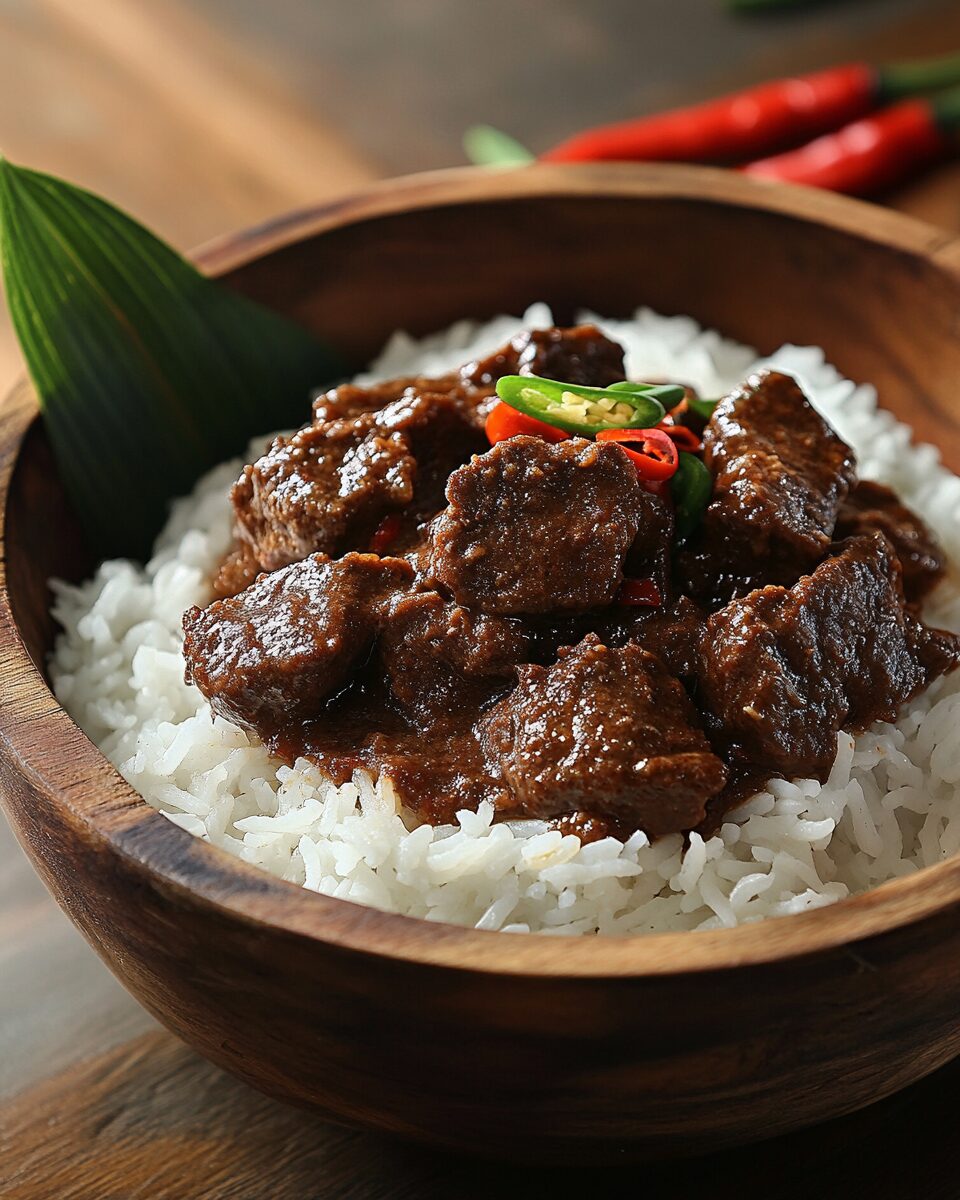Beef Rendang is a celebrated dish in Malaysian and Indonesian cuisine, known for its rich, slow-cooked coconut curry base and deeply aromatic spices. This dry-style curry features tender chunks of beef simmered for hours in coconut milk and a spice paste until the sauce thickens into a flavorful coating. Traditionally served during special occasions and gatherings, Beef Rendang is a showcase of patience, culture, and unforgettable Southeast Asian flavors.
Full Recipe:
Ingredients
-
1.5 kg (3 lb) beef chuck, cut into large cubes
-
12 dried chilies (or fresh long red chilies)
-
2 onions, roughly chopped
-
5 cloves garlic
-
2 stalks lemongrass (white part only)
-
5 cm (2 in) piece galangal (or substitute with ginger)
-
1 tbsp ground coriander
-
1 tbsp ground cumin
-
2 tsp ground turmeric
-
400 ml (14 oz) coconut milk
-
2 cups water
-
3 kaffir lime leaves, finely sliced
-
2 tsp tamarind puree (or 2 tsp lemon juice)
-
Salt to taste
-
2 tbsp vegetable oil
Directions
Step 1: Prepare the Spice Paste
Blend chilies, onions, garlic, lemongrass, and galangal in a food processor until smooth.
Step 2: Sear the Beef
Heat oil in a large pot over high heat. Brown half of the beef cubes, remove, and repeat with the rest.
Step 3: Sauté the Spice Paste
Reduce heat to medium-low. Add the blended spice paste and cook for 2–3 minutes until it darkens slightly.
Step 4: Build the Curry Base
Return all the beef to the pot. Add coriander, cumin, turmeric, coconut milk, water, kaffir lime leaves, and tamarind puree. Stir to combine.
Step 5: Simmer Covered
Cover and simmer on low heat for 1 hour and 15 minutes, stirring occasionally.
Step 6: Reduce to Paste
Uncover and continue to simmer for another 30–40 minutes, stirring often, until the sauce thickens into a paste that clings to the beef.
Step 7: Serve
Serve hot with rice, optionally garnished with extra sliced kaffir lime leaves.
Nutrients (Per Serving, Approximate)
-
Calories: 480 kcal
-
Protein: ~35g
-
Fat: ~32g
-
Saturated Fat: ~20g
-
Carbohydrates: ~10g
-
Fiber: ~2g
-
Sugar: ~3g
-
Sodium: varies based on salt added
-
Cholesterol: ~95mg
Cultural Significance
Originating from the Minangkabau ethnic group of West Sumatra, Indonesia, rendang is traditionally prepared for ceremonial occasions, weddings, and important feasts. Its ability to be preserved for days without refrigeration made it ideal for long journeys and communal gatherings. In fact, rendang’s extended cooking process not only intensifies the flavors but also acts as a natural preservative—an important feature in tropical climates. Over time, this dish has spread across Southeast Asia and gained international acclaim, symbolizing heritage and hospitality. In Malaysia, it’s a staple during Hari Raya celebrations, and in Indonesia, it holds a sacred spot during Ramadan and family events.
What Makes Rendang Unique
Unlike typical curries that are saucy or brothy, rendang is a “dry curry.” The dish begins with a rich coconut milk base that slowly reduces over a couple of hours until it becomes a thick, almost caramelized coating around the beef. The spices are deeply aromatic, with layers of ginger, lemongrass, garlic, and galangal blending into a rich tapestry of flavor. The slow simmer allows the beef to tenderize gradually while the coconut milk thickens and browns, forming a savory crust that sticks to the meat. It’s this dual process of infusion and reduction that gives rendang its hallmark richness and depth.
Why You’ll Love This Recipe
Beef Rendang is not just food—it’s an experience. You’ll love this recipe for its robustness, complexity, and how effortlessly it elevates a simple dinner into something extraordinary. It’s the kind of dish that makes your kitchen smell incredible for hours, builds anticipation with every stir, and rewards you with fork-tender beef drenched in a luxurious, spiced coconut coating. It reheats beautifully, making it perfect for make-ahead meals or gatherings. It’s also adaptable—though the process takes time, the technique is straightforward and requires just a bit of commitment for outstanding results.
Flavor and Texture
Beef Rendang is all about bold, complex flavors and melt-in-your-mouth texture. The spice blend brings warmth, depth, and just enough heat to make each bite interesting without overpowering the palate. Coconut milk provides richness and sweetness, balanced by the tanginess of tamarind or lemon juice. As the sauce cooks down, it thickens and clings to the beef, forming a dark, almost candied coating. The result is a dish with multiple dimensions—fragrant, meaty, slightly nutty from the coconut, and deeply savory.
Health Benefits
Despite its indulgent taste, Beef Rendang contains a number of beneficial ingredients. Lemongrass and galangal have anti-inflammatory properties and aid digestion. Garlic and onions provide heart-healthy sulfur compounds. Coconut milk, though high in saturated fat, also contains medium-chain triglycerides (MCTs), which may support energy metabolism. While beef is rich in protein, iron, and B vitamins, it’s best to enjoy this dish in moderation and pair it with nutrient-dense sides like steamed vegetables or brown rice for balance.
Serving Suggestions
Beef Rendang is traditionally served with steamed white rice or nasi lemak, Malaysia’s fragrant coconut rice. For a more rustic or celebratory spread, accompany it with roti canai, turmeric rice, or nasi kerabu (blue rice). Sides like pickled vegetables, cucumber salad, or lightly sautéed greens add freshness and contrast the richness of the rendang. Garnishing with finely sliced kaffir lime leaves or toasted coconut flakes can enhance aroma and texture.
Common Mistakes to Avoid
One of the most common mistakes is rushing the cooking process. Rendang requires time—cutting it short means sacrificing flavor and texture. It’s also important not to stir too aggressively toward the end, as the meat can break apart when it’s ultra-tender. Overcrowding the pot can lead to uneven cooking; ensure the beef has enough space to sear and absorb flavors properly. Lastly, using low-fat coconut milk or substituting it with a non-fat alternative will compromise the richness that’s essential to rendang.
Ingredient Spotlight: Galangal
Galangal, often mistaken for ginger, plays a crucial role in rendang’s unique flavor. It’s slightly more peppery and citrusy than ginger, adding a bright, spicy edge to the curry. In traditional Southeast Asian cooking, galangal is used not only for its flavor but also for its medicinal properties. If you can’t find fresh galangal, use ginger as a substitute, though the flavor will be slightly different. Many Asian grocery stores also carry frozen or dried galangal, which can be rehydrated for use in this dish.
Perfect Pairings
To complete your Beef Rendang meal, pair it with side dishes that add lightness and contrast. A crisp cucumber salad with rice vinegar dressing, or a tangy green papaya salad, adds brightness. For drinks, try a refreshing lemongrass iced tea, coconut water, or a glass of crisp Riesling if you’re going the wine route. Dessert options like mango sticky rice or pandan jelly can complement the meal’s tropical flavors.
Variations to Explore
While beef is the most traditional protein, rendang can be made with lamb, chicken, or even jackfruit for a vegetarian twist. Chicken rendang typically cooks faster and results in a lighter dish, while lamb rendang takes on a deeper gaminess. For a spicier version, increase the number of chilies or add bird’s eye chili to the spice paste. Some regional variations include toasted coconut or kerisik, which adds a nutty depth to the final dish. You can also experiment with a pressure cooker to reduce cooking time, though the flavor may not be quite as developed.
Conclusion
Beef Rendang is the ultimate slow-cooked comfort food—deeply aromatic, luxuriously rich, and undeniably satisfying. A celebration of Southeast Asian culinary mastery, this dish embodies the essence of patience and precision. From the bold spice blend to the creamy coconut reduction, every element is carefully layered to create a harmonious, unforgettable meal. Though it requires time, the end result is well worth the wait. Whether you’re serving it for a festive occasion or making it as a treat for yourself, Beef Rendang is a meal that tells a story—of culture, craftsmanship, and culinary love.

